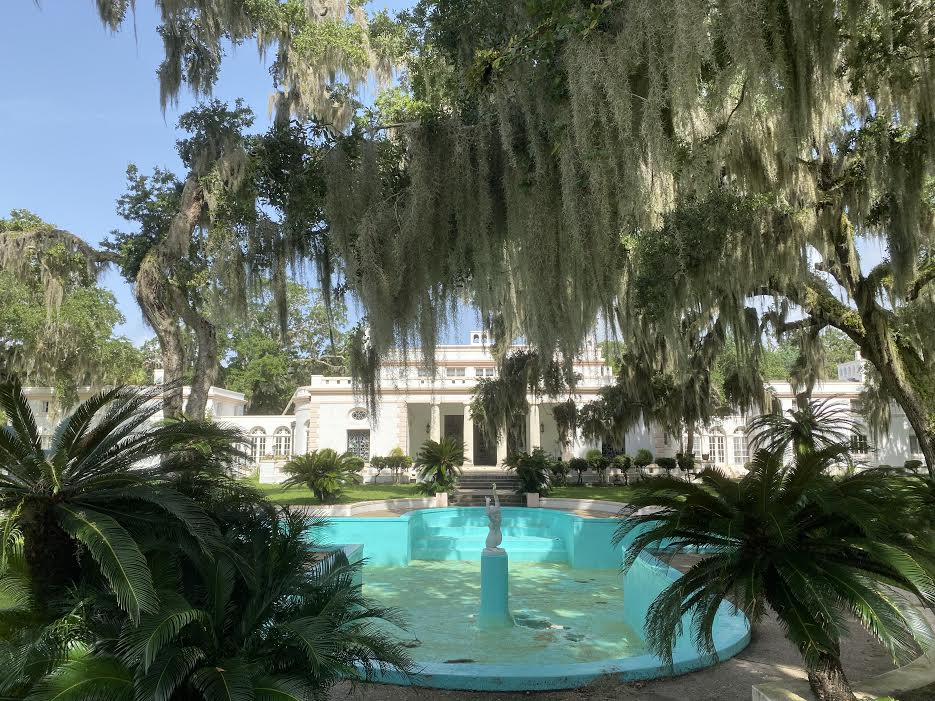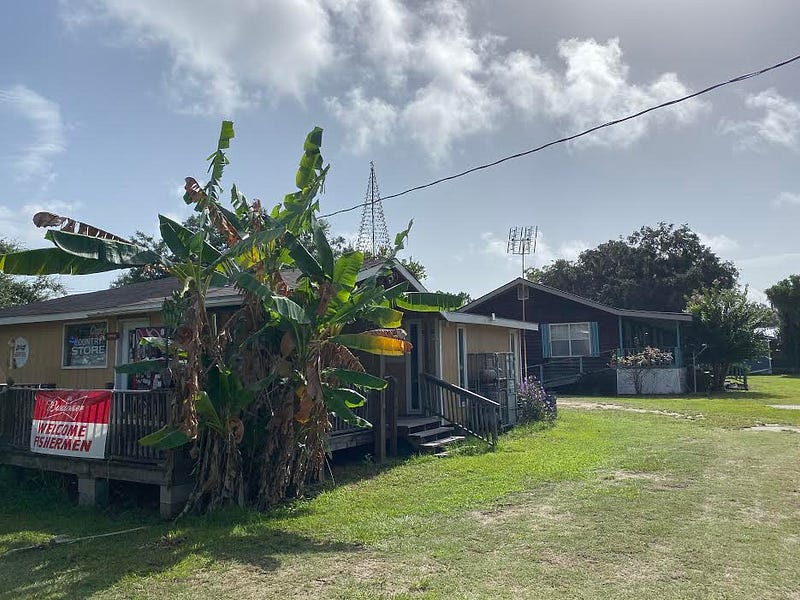In the Golden Isles of Georgia, the Gullah art of sweetgrass basket weaving has survived for more than two centuries. Enslaved West Africans, the ancestors of the Gullah people, originally wove the baskets for rice cultivation—a common labor of the Gullah Geechee population, who were most often bound to rice, indigo, or Sea Island cotton plantations. On Sapelo Island, where the last intact Gullah Geechee community in the country resides, basket weaving is now preserved as a decorative and symbolic pursuit, rather than utilitarian. Resident Sharon Grovner tells me of her plans to pass down the art to her children’s children. “I told my grandson that you’re old enough now that I’m actually going to teach you to do the sweetgrass basket,” she says as we tour the remote, sparsely-populated geography of her home, “And when his sister gets older, with God’s grace and mercy, I’m gonna show her too.”
The continuation of the fragile Saltwater Geechee culture on Sapelo Island hinges on the investment and cooperation of each new generation, which recedes as many young adults leave the island to pursue better opportunities elsewhere. The island has grown less appealing for many locals as deep-pocketed mainlanders buy up parcels of land and build extravagant vacation homes, often at odds with local zoning ordinances. The newcomers drive up property appraisals, leaving Geechee homeowners with exorbitant property taxes on their own modest homes.
Residents of the small community of Hog Hammock now find themselves embroiled in a legal battle against their own county, alleging racial discrimination in regard to taxation and the public services that should follow. “McIntosh County, Sapelo Island’s local government, provides essentially no services on the island. The island has no school, no firehouse, no medical services and no police,” reads a 2019 amended complaint filed by a group of Geechee plaintiffs. “The county does not adequately maintain the roads and does not contribute to any water or sewer system. Nonetheless, the county charges the Sapelo’s Gullah-Geechee landowners significant property taxes.”
The tax hikes began in earnest back in 2012, after the McIntosh County Board of Assessors used a sales-ratio analysis—based on recent land sales—to appraise lots in Hog Hammock. In the small community of under 50 year-round residents, the addition of just a few high-value parcels was enough to drive up property taxes for everyone by an average of five-fold. One of the plaintiffs saw the appraisal of his land rise from $10,500 in 2011 to $331,650 the next year; another saw the assessed value of her family’s land increase from $7,500 to $191,000.
Despite county tax increases by as much as 1,000 percent in one year, residents of the small, largely self-sufficient neighborhood did not benefit from a proportional improvement in public works or infrastructure. Fred Hay—the island manager for the Georgia Department of Natural Resources—elaborated on some of the services that the state, not McIntosh County, manages on Sapelo. “We provide the ferry system for the island, also the National Estuarine Research Reserve System and the wildlife management area, which is most of the North end of the island,” he said. “The fourth area is really regarding services like fuel and trash and water, municipal services.”
The state’s trash collection is done in partnership with the county, but per the 2019 complaint, “The County charges every County resident an annual garbage fee. On the mainland, that fee guarantees curbside pickup. On the Island, the fee guarantees nothing. The Island’s Gullah Geechee must haul their own trash, in their own vehicles, to a State-maintained dumpsite.”
Instead, the millions of dollars collected by the county in property taxes and provided by state and federal grants go toward funding public services on the county’s predominantly white mainland. This discrepancy is not lost on the Gullah plaintiffs from Sapelo, who see the one-sided extraction as a systematic effort to rid the island of its generational inhabitants and make way for wealthy developers and buyers.
“Historically, for African American landowners—especially in the south and especially in areas that have been experiencing pressures to develop real estate—we have seen time and time again property assessments, being used consciously or unconsciously, as a tool of displacement,” said Andrew Kahrl, who researches the social, political, and environmental history of real estate, land use, and taxation at the University of Virginia. “Public officials have a vested interest in promoting development—development is what increases their tax base. It’s what brings in revenue. It’s almost written into the very structure of local taxation in America. And this has been going on for generations. It’s been one of the key factors in the precipitous decline of black land ownership over the course of the 20th century.”
Citing a Washington Post study from July of this year, Calvin Schermerhorn—a historian of slavery, capitalism, and African American inequality—noted that black land and homes have historically been overvalued by tax assessors. “If you look at all land and residences in the country, black owners are paying on average 13 percent higher in property taxes versus white owners. County assessors will deliberately over-assess lands held by black owners for the purposes of property taxes.”
And unfortunately for Sapelo’s inhabitants, the options for legal recourse are limited. In January of this year, a federal judge dismissed three of the four claims made against McIntosh County. “Assessment practices have been remarkably shielded from legal scrutiny and lawsuits. There are a lot of barriers in place,” Kahrl told The Dispatch. “At the federal level, there are very few options to change those practices.”
Now, this vibrant community and culture born from the pernicious plantation system and generational enslavement faces an existential threat after surviving 200 years. What began as a community of 370 freedmen gradually dwindled to less than 50 year-round residents, and the remaining families on the island are facing the dual push of property taxes and pull of wealthy buyers and better opportunities elsewhere.
Thomas Spalding, born to the Georgia barrier islands, bought up most of Sapelo Island in 1843 to build his sugarcane empire. By the 1850s, Spalding and his direct descendents oversaw 385 enslaved people on the island. When the Civil War ended, most of those black workers and their children stayed in place and Sapelo became home to a large community of freedmen. The islanders established First African Baptist Church in 1866, indicating that their makeshift new community was there to stay.
Spalding’s land was sold off in pieces following the Civil War, but eventually made its way into the hands of automotive engineer Howard Coffin between 1922 and 1934. When the Great Depression struck, Coffin sold his land to tobacco heir R.J. Reynolds Jr., who bought up large tracts of land for the eventual construction of his mansion and hunting grounds. Sapelo Island’s black communities were displaced, coming together in one inland area of the island.
“Through coercive and exploitative tactics, Reynolds claimed ownership to all of the Island except portions of Hogg Hummock, where he forced all of the Gullah Geechee descendants to live,” reads the 2019 complaint. When Reynolds died in 1964, his widow sold most of Sapelo to the state of Georgia. Grovner estimated that about 38 year-round residents now live in Hog Hammock, and that most are descended from Thomas Spalding’s enslaved workers. Despite the island’s shifting ownership, the black community on Sapelo has remained a constant.
“Sapelo Island is sacred ground to the culture,” Griffin Lotson—the national vice chairman of the federal Gullah Geechee Cultural Heritage Corridor Commission and seventh-generation Geechee—told The Dispatch. “I like to call it the last of the Mohicans. You have the last intact piece of Gullah land in America on Sapelo Island.”
“These islands are where African American ties to the land go back to the earliest days of North American slavery, right through emancipation, and up to the present,” said Kahrl. “We’re not just talking about any type of property or community, we’re talking about some of the most long-standing, historically significant, communities of color in North America. To see them being eaten away and pushed off these islands is a travesty.”

The now state-owned Reynolds mansion still stands at the south end of the island, hosting large groups of guests and providing work to residents of Hog Hammock. “I just retired from the Reynolds Mansion, my husband retired and a few other people did too as well,” Grovner told me. “He was ground maintenance and I was a food service worker and kitchen supervisor. I did that for over 30 years and he did it for over 30 years.” Her mother, Lula Walker, also headed the mansion’s kitchen. At the age of 72, she now operates the island’s only restaurant: Lula’s Kitchen. “She based the kitchen off of my great great grandmother, who taught her all the steps for how to cook,” Grovner said. “Now she cooks for groups. They call and make reservations with her and she caters meals for them.”
Lula’s Kitchen is one of the few commercial operations in Hog Hammock. Other than a small general store, a schoolhouse-turned-library, the restaurant, and two active churches, the community is largely residential. Therein lies the problem for young Gullah Geechee seeking work. The small ferry that connects Sapelo to the mainland runs three times daily during the week, docking eight miles north of the nearest city of Darien, but most residents of Hog Hammock opt to pick up odd jobs around the island. Several of the community’s Airbnb’s are owned and operated by Geechee hosts, for example. But as dwindling local opportunities coincide with rising property taxes, the path of least resistance for many is to leave Sapelo Island for good.
A stroll through Hog Hammock quickly reveals the source of the surging tax appraisals. Massive vacation houses tower above the modest homes owned by Gullah Geechee families. Grovner explained that the vacationers typically only come by only on weekends, or for a few weeks out of the year, making the community distinctly silent during weekdays in the off season. “The vacation home construction is noticeable. When you ride around the island, you can see that,” said island manager Fred Hay.
“That’s something we’ve been dealing with for such a long time and all, we’re trying to be grandfathered in, so we can pay reasonable fees for our taxes, but people who choose to build enormous houses can pay the taxes for their property,” Grovner told us. “If you want to build a glamorous and large house, then you pay the taxes for it. Not us. And that’s what we’re trying to do,” she said, alluding to the ongoing litigation.
Fortunately, Grovner and the residents of Sapelo Island have at least a few elected officials on their side. State Rep. Jeff Jones, who represents parts of McIntosh County, recommended a legislative remedy to the rising taxes. “Depending on how the legislation was written, we could extend tax freezes to just the Gullah Geechee community. Let the people who have bought up their property pay fair market property taxes, but protect the culture. Historic cultures like theirs have long been squeezed out of their homes because property taxes have risen so much,” he told The Dispatch. “It would be done at the state level, but the local governing authority would need to buy into it. The county could put forth a resolution supporting that action.”
“We need local legislation first, then state legislation to back it up and create a law. As I tell people, why was the enslavement of the Gullah Geechee people legal? Simple, they created a law,” said Griffin Lotson. “Anytime you create a law, it makes your practice legal, whether we like it or not. So we have to rid ourselves of some laws and create new ones.”
When asked if he would back such a move, McIntosh County Commissioner Dr. Roger Lotson, Griffin Lotson’s brother and representative for Sapelo Island on the county Board of Commissioners, agreed. “How do we accommodate new residents, moving in and building homes of greater value, and at the same time try to respect those who have lived on the island forever?” he said. “This has been an ongoing issue from both the county and the state level.”
Both Jones and Dr. Lotson pointed out that part of the problem lies in McIntosh County’s very small taxable base. According to a report published in 2018, roughly one-third of the county’s land area—85,232.83 acres—belongs to the state and federal governments. The State of Georgia owns approximately 97 percent of Sapelo Island, for example. Largely purchased to preserve the area’s rich ecology, these swaths of land are free from taxation and development.
“Broadly speaking, McIntosh County has the highest percentage of land that has been removed from the tax rolls by virtue of purchases from the state or the feds,” said Jones. “The larger picture is McIntosh County has very little tax base and they need to generate property tax revenue from whatever property is taxable within the County.”
Dr. Lotson concurs. “To the County Commission, that is a large issue. We would be able to provide greater tax breaks across the board in McIntosh County if the state and federal governments would give us our fair tax value,” he said. “State and federally owned properties are off our tax digest and they’re valuable land that we get nothing from.”
Though Jones and Dr. Lotson agree that incurring possible costs is worth preserving the rich cultural heritage of Hog Hammock, some McIntosh locals are hesitant about such legislation. And Griffin Lotson predicts that the Board of Commissioners might ultimately reflect the reservations of its constituents. “All it takes is three votes to establish the local law and take it to the state. Getting three people to agree about that when there’s a lot of money on the table, that’s the hiccup right there,” said Griffin Lotson. “The city is broke. We need to come up with creative ways to save the property that generate money.”
In the meantime, Sharron Grovner thinks that the best way to hold onto her property is to stay put. “I willed mine to my children. I’m not selling my land. The land goes to my children and my grandchildren, and I hope they keep it,” she told The Dispatch. “You’ve got those that don’t live here that sell. And when they sell, they don’t realize that when their grandchildren and great grandchildren want to come back, and they don’t have any place to come to. So it’s sad that it happens, but it happens.”







Please note that we at The Dispatch hold ourselves, our work, and our commenters to a higher standard than other places on the internet. We welcome comments that foster genuine debate or discussion—including comments critical of us or our work—but responses that include ad hominem attacks on fellow Dispatch members or are intended to stoke fear and anger may be moderated.
With your membership, you only have the ability to comment on The Morning Dispatch articles. Consider upgrading to join the conversation everywhere.